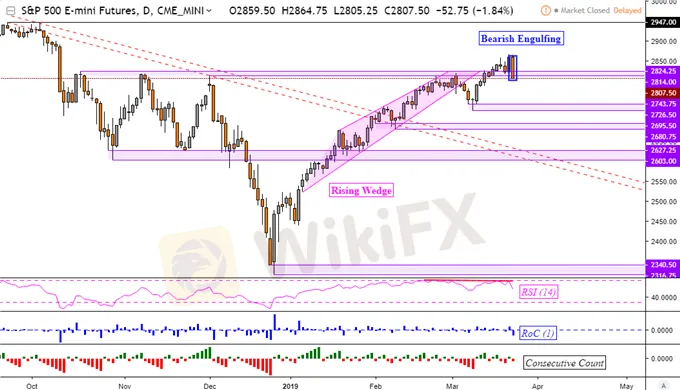简体中文
繁體中文
English
Pусский
日本語
ภาษาไทย
Tiếng Việt
Bahasa Indonesia
Español
हिन्दी
Filippiiniläinen
Français
Deutsch
Português
Türkçe
한국어
العربية
S&P 500 Falls, Leaves Reversal Warning. Japanese Yen May Gain
Abstract:Sentiment collapsed on Friday following dismal European economic data with the S&P 500 leaving bearish reversal warnings. Asia Pacific stocks may fall as anti-risk Japanese Yen gains.
The British Pound was one of the best-performing majors on Friday, outperforming as UK Prime Minister Theresa May bought more time for the Brexit deadline in the event her divorce deal does not pass in parliament this week. Sterling also had a slew of dismal European PMI to thank, which weakened the Euro. Keep in mind that these followed a more dovish ECB, adding to concerns about economic weakness.
Risk trends took a turn for the worst, with the S&P 500 dropping almost 2%, wiping out all cautious upside progress that led into Friday. In fact, the spread between US 3-month and 10-year government bond yields, a closely-watched section for recession signals, turned negative for the first time since 2007. Unsurprisingly, the anti-risk Japanese Yen largely outperformed against its major counterparts. The US Dollar also rose.
S&P 500 Technical Analysis
Using futures to show after-hours trade, the S&P 500 had its worst day this year so far as prices formed a bearish engulfing at the recent top. Negative RSI divergence accompanied the indexes push above key resistance at 2824, showing fading upside momentum. This may precede a turn lower towards support at 2726, especially given confirmation of another close to the downside.
S&P 500 Daily Chart

Chart Created in TradingView
Mondays Asia Pacific Trading Session
As the new week begins, the Asia Pacific economic docket is relatively light. This places the focus on risk trends. As such, we may see regional bourses follow Wall Street lower. Nikkei 225 futures closed at their lowest since March 8th on Friday. This may send the pro-risk Australian and New Zealand Dollars lower as the Japanese Yen may extend its advance from Friday.
US Trading Session Economic Events

Asia Pacific Trading Session Economic Events

Disclaimer:
The views in this article only represent the author's personal views, and do not constitute investment advice on this platform. This platform does not guarantee the accuracy, completeness and timeliness of the information in the article, and will not be liable for any loss caused by the use of or reliance on the information in the article.
Read more

KVB Market Analysis | 28 August: Yen Strengthens on BoJ Rate Hike Hints; USD/JPY Faces Uncertainty
The Japanese Yen rose 0.7% against the US Dollar after BoJ Governor Kazuo Ueda hinted at potential rate hikes. This coincided with a recovery in Asian markets, aided by stronger Chinese stocks. With the July FOMC minutes already pointing to a September rate cut, the US Dollar might edge higher into the weekend.

KVB Market Analysis | 27 August: AUD/USD Holds Below Seven-Month High Amid Divergent Central Bank Policies
The Australian Dollar (AUD) traded sideways against the US Dollar (USD) on Tuesday, staying just below the seven-month high of 0.6798 reached on Monday. The downside for the AUD/USD pair is expected to be limited due to differing policy outlooks between the Reserve Bank of Australia (RBA) and the US Federal Reserve. The RBA Minutes indicated that a rate cut is unlikely soon, and Governor Michele Bullock affirmed the central bank's readiness to raise rates again if necessary to combat inflation.

Can someone earn $1 million at once on forex trading? If yes, how can this be done?
In conclusion, while it is theoretically possible to make $1 million at once in forex trading, achieving such a remarkable feat requires exceptional expertise, meticulous risk management, and a deep understanding of the complexities of the market. Aspiring traders should approach forex trading with rational expectations, a focus on continuous improvement, and an emphasis on preserving capital as the foundation for long-term success in this dynamic and challenging market.

Type of Accounts Offered by Giraffe Markets
Each type of account is tailored to meet the diverse needs and preferences of traders, ensuring that there's an option suitable for every level of expertise and trading style with Giraffe Markets.
WikiFX Broker
Latest News
XM - Featured Broker in WikiFX SkyLine Guide
BUX and PrimaryBid Partnership Opens IPO Access for EU Retail Investors
Plus500 Users Count Surges to 121K with Average Deposits Reaching $6,150
Coinbase Launches Tool to Simplify AI Agent Creation for Crypto Tasks
Illegal Bitcoin Mining Is Draining Millions from Malaysia’s National Company
Angel One is an Ideal choice for you ?
Canadian Watchdog Warns Against Capixtrade
StoneX Group Strengthens Indian Presence with Bullion Exchange Membership & New Offices
Indonesian Woman Lured into S$1.3 Million Forex Scam by Friend
6 Trading Platforms That May Put Your Money at Risk
Currency Calculator


